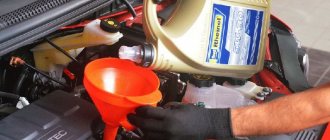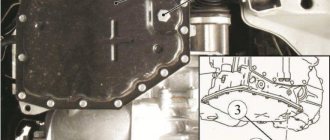- 1. Which ATF should I choose?
- 2. How to change the oil in an automatic transmission VW Polo Sedan: detailed instructions
- 3. Features of the procedure
and Volkswagen Polo is equipped with Japanese-made Aisin 09G automatic transmissions.
At factories, automatic transmissions are filled with transmission fluid for the entire service life. However, in Russia it is necessary to change the oil, since used cars from the EU are often sold that have already run more than 100 thousand km. Frequency of oil change in Volkswagen Polo automatic transmission
Transmission oil is filled into the Aisin automatic transmission for its entire service life - 120 thousand km. The recommended period for checking the fluid is 60 thousand km. Volkswagen showroom technicians advise changing ATF at the following intervals:
60 thousand km - complete or partial replacement depending on the level and condition of the oil. If there is a change in color, viscosity, contamination or odor, the liquid is completely changed.
40 thousand kilometers - when driving in difficult conditions, as well as during the first partial replacement (4 liters of transmission).
It is necessary to replace not only the transmission fluid, but also the accompanying automatic transmission parts - oil filter (09G325429 or Meyle 100 137 0001), transmission pan gasket. You will also need a drain plug (code - WHT 000 310 A) and an O-ring for it. This applies to partial ATF changes.
It is recommended to inspect the condition of the fluid in the automatic transmission every 40-60 thousand kilometers. When driving in a metropolis (when traffic jams are not uncommon) or with an aggressive driving style, checks must be performed more often - at least every 40 thousand km.
The frequency of ATF changes is determined based on climatic conditions - for example, if the car often moves from Moscow to the Northern regions. Due to low or extremely high temperatures, additives lose their physical and chemical properties.
Transmission oil change interval
The German head office of Volkswagen recommends replacing the transmission fluid in the automatic transmission of the VW Polo every 60,000 kilometers. Naturally, German road conditions differ significantly from Russian ones. Professional mechanics who service cars recommend not to delay changing the oil in order to avoid possible major repairs or a complete expensive replacement of the unit.
It is best to change the atf in Polo every 25,000 kilometers of the car. In extreme cases, you can delay and drive up to 40,000. But every kilometer of an overdue oil change in a Volkswagen Polo automatic transmission will irreversibly affect the further life of the mechanical part.
If there is stagnant fluid in the gearbox, the automatic transmission valve body will first fail. The first to stick to the adjacent parts is the torque converter fork, and then the bearings, which should ensure the mobility of the oil pump. As a result, the valve body will fail, the complete replacement of which will significantly hit the Polo owner’s wallet.
Features of the procedure
On a Volkswagen Polo, changing the automatic transmission oil has the following features:
The transmission fluid temperature should be around 34°C (33°C is acceptable).
The level is set until the temperature reaches 45°C - otherwise you will have to repeat the procedure.
When running on a lift, you cannot use the brake; if the front wheels are spinning, you must set the speed to “neutral” and turn off the car engine.
Polo models produced in 2004-2005 may have versions of automatic transmissions with heat exchanger coolers. They need to replace ATP every 40-60 thousand kilometers along with the filter, regardless of operating conditions. This will prevent overheating.
Overfilling 200-300 ml of ATF is not a problem for the Polo model. This is an acceptable error when performing a replacement at a service center with specialized equipment. If the underfill of transmission fluid on the 09G exceeds 500-600 ml, there will be noticeable interruptions in the operation of the car’s transmission. Naturally, underfilling affects the service life of the box parts - especially if you drive in the city.
Even on younger Polo engine models, exceeding the automatic transmission oil temperature of 105°C is fraught with consequences. If you have a high-power motor, the risk of rapid failure of transmission parts increases.
It’s better not to change the TJ in a Volkswagen Polo Sedan yourself if you don’t have experience. Contact the DDCAR car service in Moscow. Our technicians will be able to not only change the oil, but also reset on-board computer errors and diagnose the condition of transmission elements during partial disassembly.
Practical advice on choosing oil for automatic transmission Polo Sedan
Although it is possible to temporarily fill a VW Polo engine with semi-synthetic oil in case of financial problems, such experiments are contraindicated with a Japanese automatic transmission that is quite patient, but at the same time demanding on the quality of oil.
You should not trust suspicious sites and stores that sell original or high-quality similar oil at prices much lower than market prices; this may turn out to be a crude fake and will lead, at best, to the appearance of kicks when driving, and at worst, to complete failure of the automatic transmission.
Read
Complete and partial do-it-yourself oil change in automatic transmission Toyota Corolla E150/E120 body
Original oil
Volkswagen recommends for its Polo Sedan to use only original branded automatic transmission oil marked by a German company. The article number of such transmission fluid is G055025A2. 1 liter will cost approximately 1300-1500 rubles.
Analogs
When you don’t want to pay a fairly significant amount for an original Volkswagen transmission fluid, you can try to find atf for automatic transmissions from independent companies. Most often, VW Polo Sedan owners use ATF from Mobil as an analogue, namely Mobil ATF 3309. The cost of 1 liter is approximately 700-800 rubles.
It is also possible to use oil from other reputable companies, such as Toyota, or Aisin, which are also manufacturers of Polo boxes. The main thing is that they have the same clearance.
Which oil to choose for your car's gearbox
What kind of oil should I pour into the gearbox? Choosing the right product depends on many factors. They will be discussed further.
Automatic in the box
In order not to make a mistake with gearbox oil, you need to carefully study the issue and focus only on reliable information:
- inspect the dipstick - some automakers put the necessary information on it; look under the hood - on a number of cars, data on the type of composition is engraved on a metal plate; leaf through the service book - the technicians always write down what kind of oil they fill into the automatic transmission; call the dealer - if you have any doubts, a specialist will be able to give you the necessary recommendations; find information on the official website; chat on forums.
The craftsmen themselves recommend looking for reliable information in the operating book. In it, the manufacturer indicates not only what oil to pour into the gearbox, but also answers to other questions.
All fluids suitable for automatic machines are marked with the abbreviation ATF. In addition, there are seasonal markings. Since each time period has its own product:
- winter 75W-90W; summer 80-250; All-season transmission oils are marked with letters and numbers - 75W-90.
Depending on weather conditions, certain properties are required from the lubricating fluid:
- in cold weather it should be dense; in hot weather have a reduced viscosity.
Experts say that when choosing which oil to buy for a transmission device, you need to focus on the frequency of changes. Since replacement of gearboxes does not occur very often, it is quite possible to get by with all-season options. They significantly save the vehicle owner’s money.
In mechanical box
Selecting oil for a manual transmission is not so simple. After all, such cars are usually operated in difficult conditions and are subjected to serious loads.
It is also important to understand that the more expensive the product, the less often you will have to change fluids
Oil for manual transmissions is marked as MTF. It could be:
- mineral; semi-synthetic; synthetics.
The first type has the most affordable cost. But even with a large number of additional additives, the quality will suffer. Therefore, it is recommended to use it only in the warm season, when there are no sudden temperature changes.
Synthetics are expensive and suitable for all seasons. But at the same time, it is characterized by increased fluidity and part of the filled liquid will certainly leak through the gaskets. Losses are sometimes up to 10%.
If we consider the degree of viscosity, then for a manual transmission it is worth buying a product marked 85W-90 or 75W-90. Such a liquid will retain its properties at temperatures from minus 12 to plus 45 Celsius. Similar indicators apply to all-season offers.
The GL marking is also important. It reflects the properties of transmission oil:
- protective; anti-wear; detergents and more.
The best option for the box would be the following abbreviations:
- GL-4 (front-wheel drive); GL-5 (rear wheel drive).
Lower numbers may be appropriate for cars manufactured decades ago. Six markings are used for boxes subject to extreme loads.
To be sure not to make a mistake when choosing oil for a VAZ transmission, for example, or another car, you should use one of the following tips:
- consult with a service technician; study the manufacturer's recommendations.
It would be a good idea to use both options. This thoughtful approach reduces the risk of error to zero.
Checking the level
To check the current transmission level in an automatic transmission on a Volkswagen Polo, you need to purchase high-quality transmission fluid in advance, stock up on a “five” key, a funnel and several clean rags.
The automatic transmission is equipped with a special drain plug, which serves as an indicator of the need to replace and add oil.
First of all, you need to start the engine and warm up the automatic transmission. The temperature of the transmission fluid during operation should be 50-80 degrees Celsius. In order not to wait longer at idle, you can make a short trip lasting 10-15 minutes at an outside temperature of 20-25 degrees to speed up the warm-up. The oil temperature can be determined using special equipment that is connected to the car via an OBD connector. This can be software for a computer connected via a scanner, or a mobile phone if the OBD scanner supports connecting to smartphones via Bluetooth or Wi-Fi.
Read
Do-it-yourself complete and partial oil change in a Hyundai Solaris automatic transmission
During the test, the Polo must be on a perfectly horizontal surface with the parking brake fully applied. The engine starts at idle speed and the heating and air conditioning system is completely turned off.
With the engine running, it is necessary to squeeze the brake all the way and, without releasing it, turn on all available speeds one by one, starting from “P” (Parking) up to “D”, constantly stopping at each position so that the oil completely flows throughout the valve body. After this, the car is set to neutral speed and the brake is released.
The oil level in the box in the Polo is monitored only at the correct temperature. Low temperature contributes to its overflow, and at high temperature it leads to its insufficiency.
At the bottom of the car, exactly under the location of the automatic transmission, a vessel is placed to drain the used oil. After this, the ATP quantity control plug is carefully unscrewed. An important condition for this is the need to replace the ATF control screw seal.
After this, you need to carefully monitor the Polo pan and the temperature through the scanner - with normal quantities and proper functioning of the box, transmission fluid will begin to drip at a temperature of 35-37 degrees. Before the Polo gearbox reaches a temperature of 40 degrees Celsius, it is necessary to place a new seal on the control screw and tighten the screw with a torque wrench to a torque of 27 Nm. The control screw must be tightened back until the box reaches 45 degrees (in the case of very hot weather or climate, up to 50 degrees is allowed). If at a temperature of 45 degrees Celsius or more the liquid does not begin to flow out, it is necessary to add oil.
The fluid that has drained from the automatic transmission must be visually assessed - if it is too cloudy, contaminated with small parts of the clutch packs or smells like burning, then a complete replacement is required. Also, this may indicate serious damage to the box and be the first and main signal that you need to visit a service center to have the Polo examined by specialists.
Read
Do-it-yourself complete and partial oil change in automatic transmission Suzuki SX4
When should you change?
Many Volkswagen Polo owners have a question about whether it is worth changing the oil in the manual transmission, since the user manual for the vehicle states that the lubricant in the box is designed for the entire service life of the car. Indeed, in a mechanical gearbox, oil is not consumed unless there are structural defects that cause lubricant leakage. However, it should be taken into account that the operational characteristics of machine components and assemblies vary depending on climatic conditions, driving style and many factors that cannot be completely calculated by the manufacturer. In addition, the concept of “operational period” is interpreted differently in our country and abroad. In Germany, the service life of a car rarely exceeds seven years, but in our country a car can be driven for more than thirty years.
A manual transmission, despite high criteria for stability and reliability, in comparison with an automatic transmission, is susceptible to the influence of external factors, poor-quality roads or complete off-road conditions, and significantly depends on the driving style
It is necessary to regularly check the oil level in the Polo Sedan box, and also pay attention to its quality. The indicators for changing the oil in a manual transmission should be the following factors:
- noises and knocks atypical for transmission units;
- difficulties when changing gears or deterioration in the controllability and maneuverability of the machine.
In addition, if, when checking the lubricant level, it is discovered that it has acquired an unnatural shade, has impurities or an unpleasant odor, this indicates the need to replace it. Service center specialists and experienced car owners recommend replacing transmission fluid at least every sixty thousand kilometers. If the car is operated in aggressive conditions, then the working components of the vehicle require more frequent maintenance, approximately every thirty thousand kilometers traveled by the car.
This is interesting: Volkswagen Polo replacing the alternator belt: break it down point by point
Materials for a comprehensive oil change in an automatic transmission Polo Sedan
Before replacing the transmission fluid in a Polo automatic transmission, you should stock up on consumables in advance (trade numbers are indicated in brackets), these are:
- automatic transmission oil filter and oil pan gasket for Polo Sedan, usually included as a set (100 137 0001);
- crankcase drain plug VW Polo (VAG - WHT 000 310 A);
- sealing ring for automatic transmission drain plug for VW Polo (VAG 09D 321 181 B).
Diagnostics and repair of automatic transmission selector position sensor
Autumn, damp weather, my selector position sensor began to act up. You start the car, drive out - everything is fine. And then, like crazy, it jumps from “D” to “N”, “Check” lights up.
Today I’ll tell you how I solved this problem. But first you need to find out what the automatic transmission selector position sensor is and how it works.
Do-it-yourself oil change in automatic transmission Polo Sedan
These instructions for changing automatic transmission oil in Polo are suitable for cars produced in 2012 and 2013. When changing the oil, you must follow some rules and do everything strictly according to the instructions, since violations of the replacement technology can lead to unwanted breakdowns of the gearbox and valve body, in particular.
Draining old oil
In Volkswagen Polo automatic transmissions, oil is drained in two stages. First of all, you need to place a previously prepared container under the drain plug. It is necessary to refill the same amount of transmission fluid as leaked from the automatic transmission.
First, the drain plug is unscrewed and approximately a liter of oil will flow into the vessel, after which it will stop flowing. The procedure is long and takes approximately 40 minutes. On the sides of the box there are 12 bolts, which can also be unscrewed to allow a little more oil to flow out. It is recommended to do this, since even more debris and dirt will come out of the box, which is better for the further operation of the automatic transmission. After this, the pan itself is carefully unscrewed, which will contain some more oil, approximately about a liter. Therefore, when dismantling it should not be tilted or turned over. After the Polo's transmission pan, the oil filter is removed, from which approximately another half liter will flow into the waste fluid container.
Washing the tray and removing chips
After removing the pan and oil filter of the Polo automatic transmission, it is necessary to thoroughly clean the pan from any dirt and chips that may be on it. To do this you will need a cloth rag and an alcohol solution. A rag is soaked in the solution and the tray is thoroughly cleaned until it is clean and smooth. After this, a new rubber gasket is placed on the automatic transmission pan, which serves to prevent oil from leaking out of the box.
Read
Do-it-yourself oil change in a Chevrolet Aveo T300 automatic transmission
Replacing the filter
When changing the oil, you must completely replace the Polo automatic transmission oil filter with a new one. This shouldn't be difficult. You need to unscrew the 3 bolts that hold it in the box and carefully remove it (as mentioned above, some more transmission fluid will drain from it). The new filter is installed in place of the old one and screwed with three bolts.
After replacing the automatic transmission oil filter, the oil pan is mounted in its original place. You can first fill it with about a liter of oil and place it back in order to reduce the time of further oil filling.
Filling with new oil
Important! The automatic transmission of the Volkswagen Polo does not have a dipstick, so it is impossible to easily check the current oil level in the box. After completely removing the used transmission fluid from the box, it must be poured into another measuring vessel to find out its quantity. You need to pour back exactly the same amount as was drained. A slight excess of 100-200 grams is possible, since oil loss during draining cannot be avoided.
To add new oil to the Polo box, there is a small special hole on the crankcase. It is located on the side and reaching there is quite problematic. In order to pour transmission fluid there, you need to take a thin rubber hose, no more than 1 centimeter in diameter and about one and a half meters long, as well as a bottle without a bottom.
Read
Do-it-yourself oil change in automatic transmission Skoda Octavia
The filler plug is unscrewed and a hose is placed there. A small round hole is made in the bottle cap where the other end of the hose will be inserted. Now you can begin the procedure of pouring new transmission fluid into the box. After everything is finished, you need to quickly pull the hose out of the filler hole, screw the plug back in and wipe the places where oil got in after pulling out the tube.
Classification of transmission oils by viscosity
One of the most important characteristics of gearbox oil is viscosity. The correct selection ensures:
- uninterrupted lubrication of all components at any temperature; increase in efficiency; reduction of losses during operation.
On the packaging this characteristic is indicated by the combination SAE J 300 DEC 95. The classification of this type was developed in the USA. It includes the following categories:
- 70W; 75W; 80W; 85W; 80; 85; 90; 140; 250.
In relation to viscosity, the indicators fluctuate in the range of 4.1-41:
- 70W-4.1; 75W-4.1; 80W-7; 85W-11; 80-7-11; 85-11-13.5; 90-13.5-24; 140-24-41; 250-41.
This system takes into account seasonality:
- a winter product is marked with the letter W with the corresponding number - the lower it is, the lower the temperature the liquid will work; summer has only numbers.
All-season lubricants have their own characteristics. In them, alphanumeric combinations are hyphenated, where:
- the first part is an indicator for the cold season; the second reflects the maximum temperature norms for summer.
Complete replacement of transmission fluid in automatic transmission
A complete oil change in the Polo automatic transmission is carried out using special equipment at a service station. The unit is connected to the hydraulics of the box and the used oil is replaced under high pressure with new oil. The replacement process can be observed by visual inspection through the device’s pipes, where you can see how dirty oil flows out of the automatic transmission and new oil gets inside.
The main disadvantages of this procedure for a car are a lot of stress for the gearbox, as well as the risk of damage to mechanical units by particles of automatic transmission wear products. In addition to this, the consumption of new oil increases by several liters. The volume of transmission fluid that is poured inside the VW Polo box is 7 liters, while a complete hardware replacement will require about 8-9 liters, which will be paid for by the owners. Most often, such a procedure must be carried out after pouring low-quality ATP, which requires complete squeezing out of the hydraulic system.
The average cost of this procedure is 3,000 rubles.
Technical regulations and possible problems
The German manufacturer advises to resort to a replacement procedure every 60,000 km. However, it does not take into account the condition of Russian roads, climate and weather conditions. Therefore, experts from dealer centers in Russian cities recommend bringing the car for maintenance to replace the transmission fluid after 25,000 km. The maximum mileage is 40,000 km. If you exceed the limit with each new kilometer, the consequences will become more critical.
If strange sounds begin to appear in the box, and the car slows down, moves jerkily, or even stops responding to gear changes, then the reason most likely lies in contaminated transmission oil, which has lost its lubricating properties.
Many car enthusiasts, in order to save on buying oil, drain only half of the used fluid and add new fluid - this is the wrong technique. For high-quality operation of all components of the unit, it is necessary to completely pour out the used oil and be sure to rinse the tank. Otherwise, the consequences may require substantial financial investments.
The automatic transmission of the Volkswagen Polo is a 6-speed unit, produced in two expensive trim levels of the Comfortline and Highline sedan. Both designs are paired with a 1.6-liter engine producing 105 hp. The “code” name of the transmission is ZF 5HP19.
If the replacement regulations are not followed, as a rule, the valve body of the box takes the first blow. First, the torque converter fork burns to the moving parts, and then the bearings fail, affecting the operation of the oil pump. As a result, the entire unit breaks down, the cost of which can cost the owner of a Polo sedan a pretty penny.
Problems with solenoids also often occur. Worn parts lead to an increase in pressure in the system, which negatively affects the operation of the drums.
Poor quality oil can also lead to wear of the oil pump cover and, as a result, the formation of leaks in the structure.
This is interesting: How to walk on a road with no sidewalk
Top 5 best oils in a box
There is currently a wide selection of transmission fluids on the market. Our rating will help you choose the best.
Automatic in the box
For automatic transmissions, the best compositions will be:
- Liqui Moly Top Tec ATF 1800; Liqui Moly Top Tec ATF 1100; ELF Renaultmatic D3 Syn; Honda ATF-DW1; Red Line 30504 D4.
It’s worth talking about each in a little more detail.
Liqui Moly Top Tec ATF 1800 is a semi-synthetic compound suitable for old and new cars. It has a number of advantages:
- stable viscosity; reliability; uniform lubrication; friction protection; prevents corrosion; reduces wear of parts; resistant to oxidation.
In addition, the liquid contains a lot of additives. The cost, depending on the volume, ranges from 600 to 3,500 rubles.
Liqui Moly Top Tec ATF 1100 is a universal composition suitable for:
- checkpoint; hydraulic boosters and more.
The advantages of the composition are numerous:
- extra class; an extensive list of additives; chemical resistance; thermal stability; reduction of friction coefficient; wear protection; increase in service life; maintaining properties even under high loads.
The price for packaging starts from 700 rubles.
ELF Renaultmatic D3 Syn is used primarily in RENAULT models. The advantages of the composition include:
- viscosity stability; uniform distribution among parts; adaptability to low temperatures; fuel efficiency; easier startup and more.
The average price for the composition is 500 rubles.
Honda ATF-DW1 – original material. It has a number of advantages:
- optimal compatibility with Honda cars; minimal oxidation; increasing the service life of the fluid; protection of seals.
A four-liter package costs about 4,000 rubles.
Red Line 30504 D4 is one of the best synthetic products on the market. Its distinctive features are:
- thermal stability; low degree of viscosity; increase in work productivity.
A liter container costs around 1,500 rubles.











